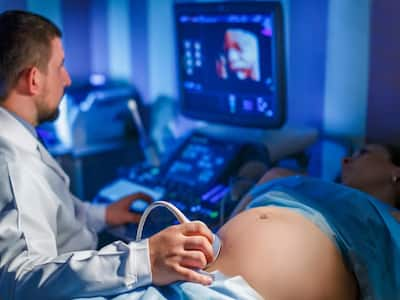
X rays, CT and PET CT scans during pregnancy may harm the developing fetus. Get to know the pros and cons of imaging tests during pregnancy.
Certain imaging tests are recommended during pregnancy to monitor fetal growth and look for structural defects in the fetus. However, it is recommended to avoid radiation exposure during pregnancy, unless they are necessary for medical reasons, as they can pose risk to the developing fetus. Ultrasound, CT scans, MRI, X-Rays: Are these imaging exams safe during pregnancy?
Dr Sonal Garg (Consultant radiologist), Dr Hiren Panwala (Consultant radiologist), Department of radiology, NH SRCC Children’s hospital, sheds light on the pros and cons of imaging tests during pregnancy.
Ultrasound and Pregnancy
Ultrasound has unequivocally been considered safe during pregnancy when used properly since they use sound waves instead of X rays. There are over 6000 citations in medical literature that have proven that ultrasound during pregnancy is not associated with adverse maternal or perinatal outcome, or impaired physical or neurological development, in childhood. It uses high-frequency sound waves to create images of the developing fetus, and there is no evidence that it poses any harm to the mother or baby. In fact, it is often used throughout pregnancy to confirm the pregnancy, monitor fetal growth, heart rate, and development, and is associated with improved fetal outcome. Ultrasound as modality is also useful to detect pregnancy related complications e.g., ectopic pregnancy, miscarriage as well as helpful with another prenatal test like chorionic villus sampling or amniocentesis.
CT and Pregnancy
CT scans are not recommended during pregnancy unless necessary circumstances prevail wherein maternal health maybe at risk such as head injury, body trauma, or malignancy in the mother. The radiation used in CT scans may increase the risk of harm to the developing fetus who is generally more sensitive to the effects of radiation than a child or an adult. If a CT scan is required during pregnancy, it is important to use the lowest possible dose of radiation and to shield the abdominal area with a lead apron or other protective barrier to minimize fetal exposure. If the pelvic region is not under direct CT beam, the exposure of radiation to the fetus maybe quite low. Overall, the number of CT scans recommended during pregnancy should be kept to a minimum and only performed if medically necessary. Contrast is generally considered safe despite of the fact that contrast material does cross the placenta to the fetus. It has been used in pregnancy without harm.
READ RELATED: 5 Health Benefits of Water: How Much Water Should You Drink Per Day?
MRI and pregnancy
MRI scans are generally considered safe during pregnancy at any trimester, although they may be less commonly used than ultrasound because of the potential of maternal discomfort and the longer scan times. MRI uses a magnetic field and radiofrequency waves to create images of the body, and there is no evidence to suggest that it poses any harm to the mother or baby. MRI may be required for maternal indications such as trauma, headache, stroke during pregnancy, musculoskeletal issues etc. MRI is also indicated for fetal pathologies like better assessment of neurologic and spine pathologies, chest and abdominal lesions which is usually performed and considered safe in the second trimester. However, MRI should only be performed during pregnancy if medically necessary. The use of contrast agent with MRI should be limited and may be used only if it significantly improves the diagnostic performance.
X-ray and pregnancy
X-rays are generally safe during pregnancy when used properly and the amount of radiation exposure is minimized. However, it is recommended to avoid routine X-rays during pregnancy unless they are necessary for medical reasons. The developing fetus is most sensitive to radiation during the first trimester, so if an X-ray is required during this time, it is important to take steps to protect the fetus from radiation exposure, such as shielding the abdominal area with a lead apron. The number of X-rays recommended during pregnancy should be kept to a minimum and only performed if medically necessary. Hence, pregnancy has to always be ruled out in a woman of childbearing age undergoing a test that requires ionizing radiation.
In general, radiologic investigations that use ionizing radiation like X rays, CT and PET CT scans, have potential teratogenic risk to the developing fetus, including the risk of malformations and childhood cancer. Hence ultrasounds and MRI which do not use ionizing radiation are generally safe.
Total Wellness is now just a click away.
Follow us on
window.addEventListener(‘load’, (event) => {
$(‘#commentbtn’).on(“click”,function(){
(function(d, s, id) { var js, fjs = d.getElementsByTagName(s)[0]; if (d.getElementById(id)) return; js = d.createElement(s); js.id = id; js.src = “//connect.facebook.net/en_US/sdk.js#xfbml=1&version=v2.3”; fjs.parentNode.insertBefore(js, fjs);}(document, ‘script’, ‘facebook-jssdk’));
$(“.cmntbox”).toggle();
});
});









